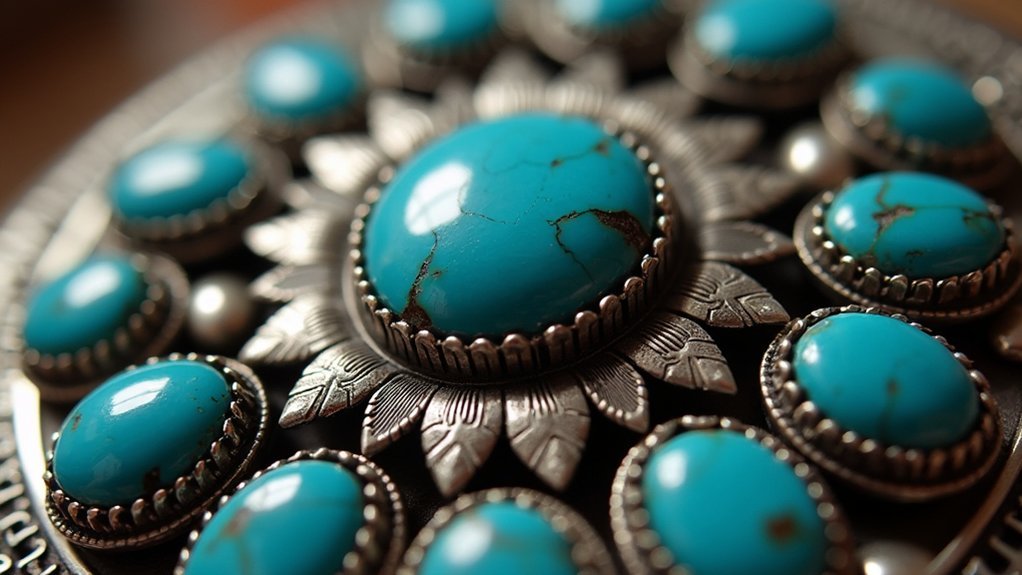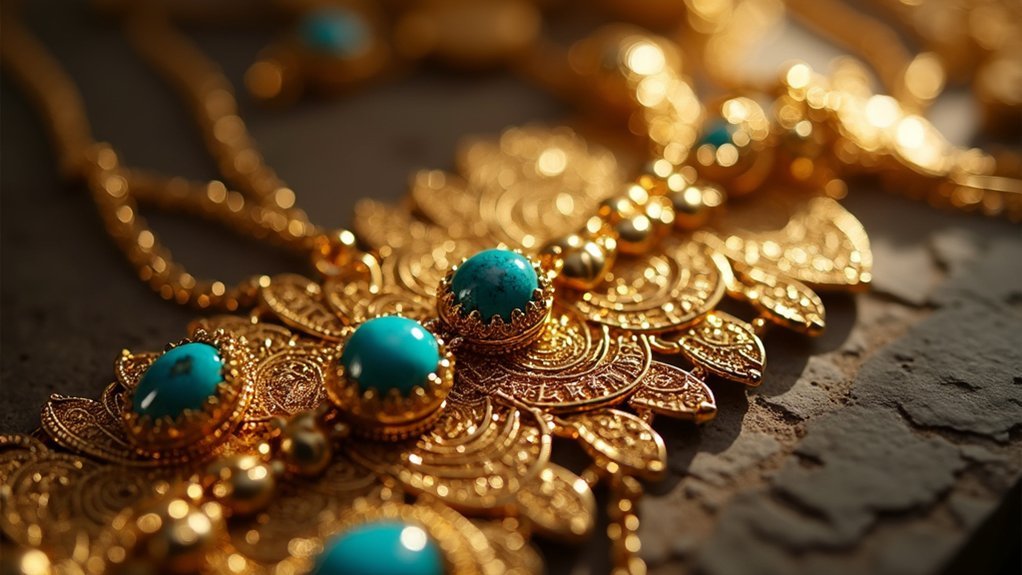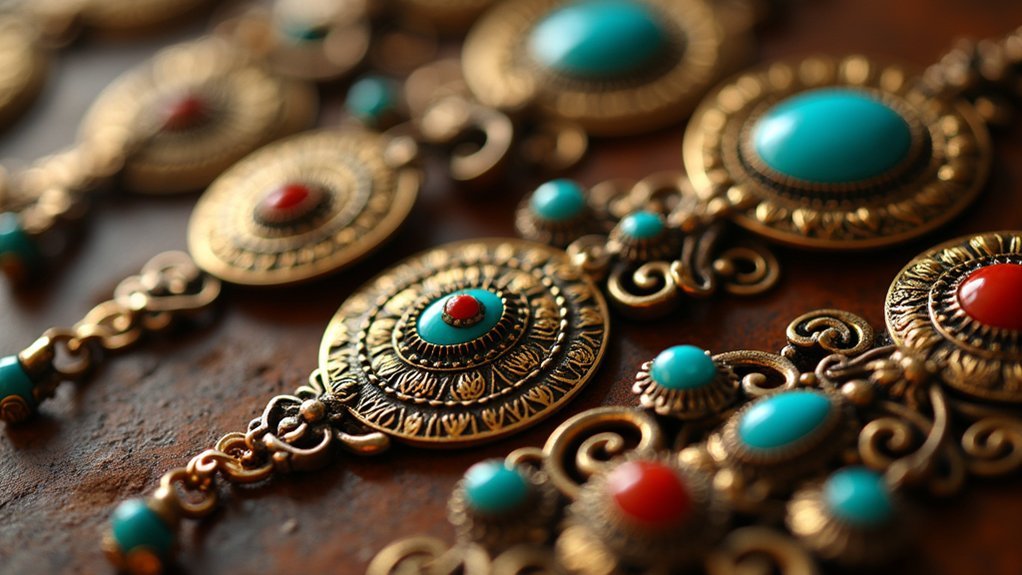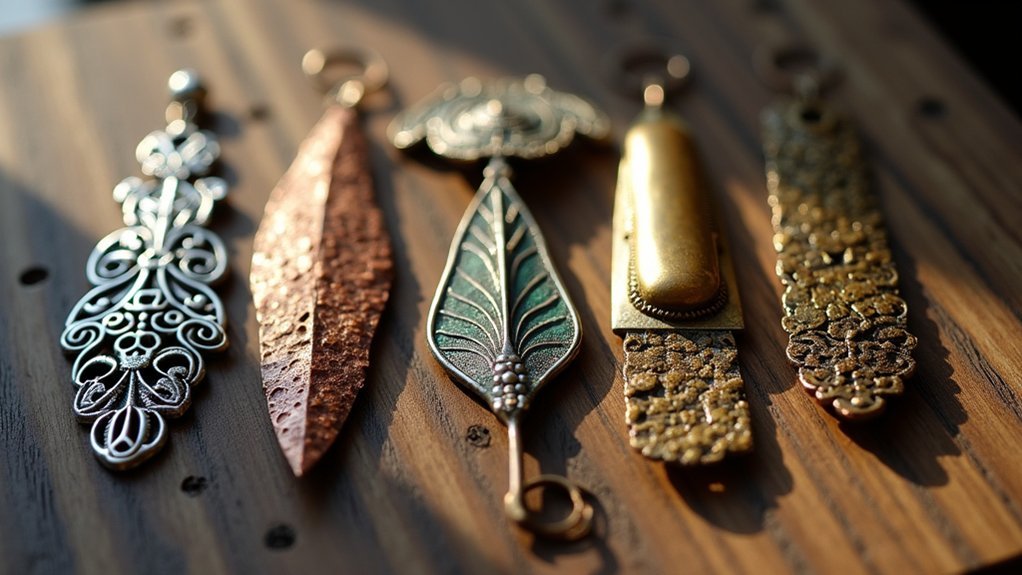Indigenous peoples have traditionally crafted jewelry from five significant metals: silver (prominent in Native American cultures), copper (valued for spiritual protection), gold (sacred in Mesoamerican societies), iron (featuring symbolic patterns in tribal communities), and brass/bronze (used across multiple civilizations for status symbols). Each metal carries deep cultural meaning beyond mere decoration, with techniques passed through generations. These metalworking traditions reveal intricate connections between cultural identity, spirituality, and artistic expression.
The Sacred Silver of Native American Cultures

While precious metals have adorned human bodies across civilizations, silver holds a uniquely profound place in Native American cultural heritage.
You’ll trace its significance to the 19th century when Atsidi Sani, the first Navajo silversmith, learned metalworking from Mexican artisans during the Bosque Redondo imprisonment.
Traditional Navajo jewelry emerged from this difficult period, with Navajo artisans developing distinctive techniques like sandcasting, overlay, and cluster work. These intricate designs often incorporate turquoise, believed to bring good fortune and carrying deep spiritual significance.
Silver jewelry remains central to Native American jewelry traditions today, with pieces that tell cultural stories and preserve identity.
Contemporary Native American silversmiths continue this legacy, creating works that honor ancestral craftsmanship while embracing modern artistic expression that collectors worldwide treasure.
Copper’s Role in Indigenous Ceremonial Adornments
Beyond silver’s prominent place in Native American artistic expression, copper holds an equally profound significance in Indigenous adornment traditions. You’ll find copper’s malleability made it ideal for ceremonial adornments that reflected cultural identity and spiritual connections.
Indigenous artisans have utilized copper’s distinctive properties to:
Copper’s malleable nature speaks through Indigenous hands, transforming raw material into sacred expressions of cultural identity and spiritual significance.
- Create intricate ceremonial pieces believed to promote spiritual well-being and protection
- Combine with gemstones and beads to enhance both visual appeal and symbolic meaning
- Express cultural narratives through jewelry making techniques passed down through generations
Today, many Indigenous communities continue this sacred practice, preserving their heritage through copper work. The metal’s warm hue and transformative potential remain central to cultural expression, connecting contemporary artisans to ancestral traditions while adapting to modern interpretations of ceremonial adornments.
Gold Significance in Pre-Columbian Mesoamerican Societies

Unlike copper’s widespread practical applications, gold held an unparalleled sacred status throughout pre-Columbian Mesoamerican societies. As a sacred metal symbolizing the sun, gold represented divine power and elite status among Maya, Aztec, and Olmec cultures.
You’ll find remarkable craftsmanship in the goldwork uncovered at sites like Peru’s Tomb of the Lord of Sipán and the Aztec Templo Mayor. Here, artisans employed sophisticated techniques including lost-wax casting and metal alloying to create intricate jewelry and ceremonial objects.
Beyond its aesthetic value, gold played an essential role in religious rituals and economic systems of indigenous societies. Tragically, the Spanish conquest in the 16th century resulted in widespread plundering of these treasures, with countless items melted down. This devastation had a profound impact on the cultural heritage of Mesoamerican civilizations.
Traditional Iron Crafting Techniques Among Tribal Communities
Among numerous Indigenous communities worldwide, iron crafting has evolved into a sophisticated art form that balances functionality with cultural expression.
You’ll find that Native American art often incorporates traditionally forged iron into detailed jewelry through techniques passed down for generations.
Jewelry makers typically employ these time-honored methods:
- Hand-forging, where artisans heat locally sourced iron in forges before hammering it into intricate forms
- Cold working, a difficult process used to create detailed jewelry without heat application
- Symbolic patterning, where craftspeople infuse pieces with spiritual beliefs, transforming functional items into protective talismans
These techniques showcase both the resourcefulness and cultural depth of tribal communities, as they’ve masterfully used iron not only for tools but also for creating meaningful adornments that connect wearers to their heritage.
Brass and Bronze Jewelry Throughout Indigenous Civilizations

While iron served essential utilitarian purposes, brass and bronze emerged as preferred metals for decorative expression across Indigenous civilizations worldwide.
You’ll find evidence of brass usage among Indigenous Filipinos dating back to 2000 B.C., influenced by Malay trade and Chinese imports. The Tboli community preserves this heritage through their kem tau temwel brass-casting tradition.
In the Pacific Northwest, Indigenous cultures incorporated brass and bronze into status-signifying jewelry featuring distinctive cultural motifs.
Beyond adornment, these metals served ceremonial functions, with craftsmanship evolving through extensive trade networks. The repousse technique—hammering metal sheets into relief designs—exemplifies the artistic sophistication of traditional metalworking.
These bronze and brass traditions showcase how Indigenous cultures developed unique approaches to metalwork while adapting techniques gained through cultural exchanges.
Frequently Asked Questions
What Did Native Americans Use to Make Jewelry?
You’ll find Native Americans crafted jewelry from natural materials like turquoise, coral, shell, and various metals including silver, copper, and brass. These pieces often held deep cultural and spiritual significance in their traditions.
What Metal Is Indian Jewelry Made Of?
Traditional Indian jewelry is primarily made of gold, silver, and brass. You’ll find gold used in bridal pieces, silver in regional designs with filigree work, and brass in tribal jewelry with colorful embellishments.
What Stone Is Used in Native American Jewelry?
Turquoise is the most iconic stone you’ll find in Native American jewelry. You’ll also see coral, lapis lazuli, onyx, and malachite frequently used, with each stone carrying cultural significance and symbolic meaning.
What Is Navajo Jewelry Made Of?
Navajo jewelry is primarily made of silver, which you’ll see paired with turquoise (Doo tl’ izh ii). You’ll also find coral, onyx, and other semi-precious stones in pieces created through traditional techniques like sand casting and overlay.
In Summary
You’ve now explored five metals deeply rooted in indigenous jewelry traditions worldwide. Each metal—silver, copper, gold, iron, and brass/bronze—carries unique cultural significance beyond mere decoration. They’re living connections to ancestral heritage and spiritual beliefs. When you admire indigenous metal jewelry today, you’re witnessing not just craftsmanship but centuries of traditional knowledge, sacred symbolism, and artistic expression that continues to influence contemporary designs.





Leave a Reply